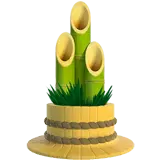Lilium nepalense (Ixc/a)

ABOUT
Lilium nepalense, commonly known as the Nepal lily, is a captivating plant well-known for its unique and striking flowers. The blossoms are large and trumpet-shaped, characterized by their rich, creamy-green base color which often transitions to a deeper purple or maroon hue towards the fringed edges. At the center of each flower, you will find prominent anthers, typically a contrasting dark brown or deep maroon, extending outward and dusted with pollen, which adds to the visual appeal of the bloom. The flowers of the Nepal lily exude a delightful fragrance that can be quite noticeable, especially in the morning and evening, attracting various pollinators. The plant has glossy, lance-shaped leaves arranged in a whorled pattern along its stem, adding to its elegant presentation. The foliage provides a lush background that accentuates the sophisticated color palette of the blooms. Overall, the Nepal lily is a compelling and attractive plant, with its distinctive trumpet-shaped flowers and aromatic presence making it a favorite among garden enthusiasts and a desirable addition to ornamental collections.
About this plant
 Names
NamesFamily
Liliaceae.
Synonyms
Nepal Lily, Lily of Nepal.
Common names
Lilium giganteum var. nepalense, Lilium wallichianum subsp. nepalense.
 Toxicity
ToxicityTo humans
Lilium nepalense, commonly known as the Nepal Lily, is not typically considered toxic to humans. There is limited information about its toxicity, as it is not a commonly ingested plant. However, as with many plants, it may cause mild stomach upset if ingested in large quantities. It's always advisable to exercise caution and avoid eating any part of ornamental plants due to the risk of gastric distress or an allergic reaction.
To pets
Lilium nepalense, known as the Nepal Lily, is considered highly toxic to cats. All parts of the plant, including petals, leaves, pollen, and even the water in the vase, contain compounds that can cause kidney failure in cats. Symptoms of lily poisoning in cats can include vomiting, lethargy, loss of appetite, kidney failure, and can be fatal if not treated promptly. Dogs are less affected, but it is still recommended to prevent them from ingesting this plant. If you suspect your pet has ingested any part of a lily, immediate veterinary attention is required.
 Characteristics
CharacteristicsLife cycle
Perennials
Foliage type
Deciduous
Color of leaves
Green
Flower color
Greenish-yellow
Height
3-4 feet (0.9-1.2 meters)
Spread
1 feet (0.3 meters)
Plant type
Bulb
Hardiness zones
5
Native area
Himalayas
Benefits
 General Benefits
General Benefits- Aesthetic Appeal: Lilium nepalense, commonly known as the Nepal lily, has large, attractive flowers that add visual interest to gardens and landscapes.
- Pollinator Attraction: The striking blooms are known to attract bees, butterflies, and other pollinators, which are beneficial for the ecosystem.
- Cultural Significance: In its native habitat, the Nepal lily holds cultural importance and is often used in traditional events and celebrations.
- Habitat Enhancement: Planting Lilium nepalense can help in the enhancement and restoration of its natural habitat, especially if it is considered rare or under threat.
- Educational Interest: The unique characteristics of the Nepal lily can serve as an educational tool for botany and horticulture enthusiasts.
- Gardening Variety: The Nepal lily adds diversity to plant collections and can be used to create a varied and interesting garden display.
- Seasonal Interest: With its seasonal blooming pattern, Lilium nepalense provides a specific time of interest in the garden, marking the arrival of summer or a particular blooming season.
 Medical Properties
Medical Properties- Analgesic: Lilium nepalense may be used for its pain-relieving properties.
- Anti-inflammatory: It can potentially reduce inflammation, although specific mechanisms are not well documented.
- Febrifuge: Traditionally used to reduce fever in some cultures.
- Antispasmodic: May be used to relieve muscle spasms or cramps.
 Air-purifying Qualities
Air-purifying QualitiesThis plant is not specifically known for air purifying qualities.
 Other Uses
Other Uses- Lilium nepalense, commonly known as the Nepal Lily, has been traditionally used in some local rituals as a symbol of purity and peace, often featuring in ceremonial decorations or offerings in the Himalayan region.
- The striking green and burgundy flowers of the Nepal Lily can be used in floral arrangements and displays, providing an exotic touch to bouquets and indoor ornamentation.
- Nepal Lilies, being nectar-rich, serve as an excellent attractant for pollinators like bees and butterflies, enhancing biodiversity and aiding in the pollination of nearby plants.
- The bulbs of Nepal Lily, when crushed, can sometimes be used as a natural pesticide in small-scale organic farming to protect crops from certain insects.
- This plant has been known to be used in crafting perfumes and scents due to its unique and attractive fragrance, though it is not a common ingredient.
- The large, striking leaves of the Nepal Lily can serve as a natural decorative element for wrapping small items, similar to how banana leaves are used in some cultures.
- Dried Nepal Lily petals can be added to potpourris to give a visually appealing look and to maintain a subtle, natural floral scent in indoor environments.
- Artists and photographers often utilize the Nepal Lily as a subject for paintings and photographs, captivated by its distinctive beauty and coloration.
- In some traditional clothing or textile dyeing practices, the vibrant hues of the Nepal Lily could be used to produce dyes for fabrics, though this practice is not widespread.
- In certain cultures, parts of the Nepal Lily plant are incorporated into handcrafted jewelry, where dried flowers or pressed petals are used to create unique, nature-inspired pieces.
Interesting Facts
 Feng Shui
Feng ShuiThe Nepal Lily is not used in Feng Shui practice.
 Zodiac Sign Compitability
Zodiac Sign CompitabilityThe Nepal Lily is not used in astrology practice.
 Plant Symbolism
Plant Symbolism- Rarity and Uniqueness: Lilium nepalense, commonly known as the "Nepal Lily," is rare and native to the Himalayas, symbolizing uniqueness due to its distinctiveness in its native habitat.
- Pride: With its elegant and prominent stature, the Nepal Lily often symbolizes pride, reflecting the tall and upright posture of the plant.
- Love and Passion: Like many other lilies, the Nepal Lily is a symbol of love and passion, representing deep affection with its vibrant blooms.
- Wealth and Prosperity: The lush and full appearance of the Nepal Lily can signify wealth and prosperity, often associated with the visual abundance the flower provides.
- Renaissance and Rebirth: Lilies in general, including the Nepal Lily, are often associated with themes of rebirth and new beginnings, perhaps connected to their perennial nature.
 Water
WaterThe Nepal Lily should be watered thoroughly when the top inch of soil feels dry to the touch, typically once a week. Use room temperature water, pouring it directly onto the soil until it begins to run out of the drainage holes at the bottom of the pot; this might amount to around half a gallon for a medium-sized pot every week, though it can vary based on the pot size and the plant's environment. During the active growth period in the spring and summer, the watering frequency may increase, while it should decrease during the dormant period in fall and winter. It's essential not to overwater, as standing water can lead to root rot.
 Light
LightThe Nepal Lily prefers bright, indirect sunlight for optimal growth. A spot near an east-facing window where it can receive gentle morning sun or a few feet away from a south or west-facing window where the light is diffused through curtains or blinds is ideal. Direct afternoon sun can be too harsh and could scorch the leaves, so it's crucial to provide protection during the brightest parts of the day.
 Temperature
TemperatureThe Nepal Lily thrives in temperatures ranging from 60 to 70 degrees Fahrenheit during the day and prefers it slightly cooler at night, around 55 to 65 degrees Fahrenheit. It can survive minimum temperatures of 40 degrees Fahrenheit but for a very short period and not without potential damage to the plant. The plant should not be exposed to temperatures above 80 degrees Fahrenheit as it can cause heat stress.
 Pruning
PruningPruning the Nepal Lily is required to remove spent flowers and any yellow or damaged leaves, which keeps the plant healthy and visually appealing. Snip off the dead flower heads after blooming to encourage further flowering and trim away any unsightly or unhealthy foliage. Pruning is best done just after the flowering period, and should be done at least once a year to maintain its shape and vitality.
 Cleaning
CleaningAs needed
 Soil
SoilThe best soil mix for the Nepal Lily should be well-draining and rich in organic matter. A blend of loam, peat moss, and perlite or sand is ideal. The soil pH should be slightly acidic to neutral, ranging from 6.0 to 7.0.
 Repotting
RepottingNepal Lilies should be repotted every 2 to 3 years. It's best to repot these plants after they finish blooming and when they are dormant to minimize stress.
 Humidity & Misting
Humidity & MistingNepal Lilies thrive in moderate to high humidity levels, ideally around 60-70%. They should not be exposed to extremely dry air as it can damage their leaves.
 Suitable locations
Suitable locationsIndoor
Place Nepal Lily in bright, indirect light indoors.
Outdoor
Plant Nepal Lily in dappled afternoon shade outdoors.
Hardiness zone
8-10 USDA.
 Life cycle
Life cycleLilium nepalense, also known as the Nepal Lily, undergoes a perennial life cycle, starting with bulb germination in late winter or early spring, where embryonic stem and root tissues develop to support the new plant’s growth. Upon sprouting, the shoots push through the soil surface and leaves begin to unfold. As the plant matures, it forms a sturdy stem and broad, lance-shaped leaves along its length, gathering energy through photosynthesis. During late spring or early summer, the Nepal Lily produces large, trumpet-shaped flowers with typically greenish-yellow petals and a purplish base, which are pollinated by insects attracted to their fragrance and nectaries. Following pollination, the flower develops into a three-chambered capsule containing several seeds, which when mature, are dispersed by wind or animal agents. Finally, as winter approaches, the above-ground foliage dies back and the plant goes dormant, with the bulb surviving underground to restart the life cycle in the subsequent growing season.
 Propogation
PropogationPropogation time
Spring-Early Summer
Lilium nepalense, commonly known as the Nepal Lily, is generally propagated through division of its bulbs. The ideal time to propagate the Nepal Lily through bulb division is in the late fall, after the plant has finished blooming and has begun to die back, ensuring that the bulb has stored enough energy. To propagate, carefully unearth the mature bulbs and gently separate any offsets, which are small bulblets that have formed at the base of the parent bulb. These offsets can be replanted immediately; they should be placed in well-draining soil at a depth approximately three times the height of the bulblet, which is typically about 4 to 6 inches (10 to 15 centimeters) for mature offsets. Ensure that the new planting site has adequate sunlight for the plant to thrive. It is critical to maintain consistent moisture without causing waterlogging to help the new bulblets establish and grow into healthy plants.









